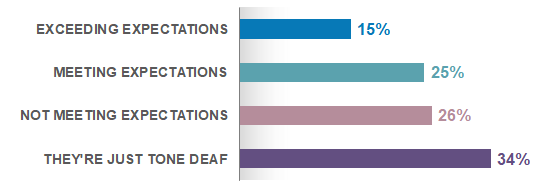
Are Vendors Delivering on the Promise of Innovation?
While emerging and innovative approaches to application design carry the promise of not only more intuitive user experiences but also of transforming ways of working, Hyperion's benchmarking has consistently demonstrated a significant divide between the value legal operations managers place on technology as a strategic capability versus the lackluster ROI they report from their technology vendors.
In the legal market, vendors are aggressively innovating their solution designs for more consumer-friendly experiences and to drive operational transformation. Recent Hyperion benchmarking sought to assess the market’s sentiment: how are legal solutions vendors delivering on their promises of innovation? While we asked legal operations managers to respond on scale of expectations, we added one harshly worded response choice that yielded a surprising yet insightful response (Fig. 1 below).
Fig 1. How are technology vendors delivering on their promises of innovation?

While fully 60% of the market feels vendors are not delivering innovation – a remarkable indictment in its own right – a full third expressed an extreme position we were frankly astonished by.
“They’re Just Tone Deaf.”
The key to understanding this response is to recognize that this is not a proxy for some kind of lowest-level option on the same scale as the other three answer choices. This does not mean, “The vendors really, really are not meeting expectations.”
Rather, a full third of the market reflected something more visceral, telling us they feel no one is listening. In the multi-billion-dollar marketplace for legal technology, there is a significant disconnect between the aspirational messages of the solution providers and the actual needs of their customers. And that’s a problem.
There are two ways of interpreting this.
Automation is Not Innovation
Much of the “innovation” that vendors tout to their customers can be characterized better as technical advancement over innovating new ways work working. In recent years, there has been quite a bit of this kind of advancement: Cloud-based virtualization, responsive HTML5 design, mobile-app development, enhanced data security, Google-like search capability, robust importing and exporting functions and revamped user interfaces with flat icons, clean lines, and balanced white space.
Yet from a lawyer’s perspective, these are not innovations to how law firms and corporate law departments actually use technology to support their jobs. The advancements in technology are effectively an extension of Moore’s Law; it is the software equivalent of “Smaller, Faster, Cheaper”—and has come to be expected.
While CIOs and system administrators of the world rejoice in architecture improvements, enhanced features and security, the end-users are more apt to see “change for the sake of change” for an application they still use to do essentially the same thing. The iPhone, by example, didn’t present an improvement over flip-phone technology (though it certainly was that, too), but innovated on the very premise of telephones. Today, we rarely use our cell phones to actually talk, and smart phone technology has literally transformed modern approaches to business applications.
This explanation might be somewhat expected. It is easy to couch this as yet another “non-tech people don’t understand technology” divide, or a geek vs non-geek parable writ large.
The second explanation is more concerning.
Legal Technology is Increasingly Client-Driven
For a long time, legal technology was more about specialization then it was about innovation. The corporate world evolved so quickly with new technologies, platforms and applications that there was a huge market for simply taking these emerging powerful pieces of tech and adapting them to the unique needs of legal professionals.
When the late-1990’s gave us server-centric networks with exponentially increasing capacity and throughput combined with the proliferation of SQL database technology, it was not hard to understand the push to combine these two specifically for law firm needs in order to create the next generation of Document Management Systems.
For many years, the legal technology user base eagerly awaited new products from IT vendors in a “What else can you offer us?” mindset. In other words, the legal technology market was very much vendor-driven, with companies determining their technology needs by the solutions available in the market. Those days are ending, if not already over. Today, technologically-mature organizations are articulating their own strategy driven specifically by the needs of the business: “This is what we need technology to do.” They are actively seeking out providers and applications that can meet their requirements. Today, the legal technology market is very much consumer-driven, characterized by the drive to support self-actualizing business needs and defined by a marked gap in the solution market’s abilities to meet those needs.
Legal operations leaders across all industries are desperately seeking better ways to manage and track outside counsel spend, but new billing report granularization doesn’t address their needs to understand how well they manage spend. Contract Management has been promising “intelligent automation” for a long time, yet we are still waiting for that AI-powered killer app. E-Discovery is only getting bigger, yet with a lack of agile big data tools, more firms are outsourcing this than even attempting it. Enterprise Content Management has constantly been the amorphous future-state of Document Management with few meaningful strides forward.
In this hyper-competitive technology-saturated landscape, differentiation is more important than ever. Simply upgrading to the next dot-x version of critical business applications is not sufficient. It’s also (refreshingly?) no longer acceptable.
Today new technology is only as good as the business problem it solves or the client-facing process it reinvents. The subject matter experts are no longer the software developers or integrators; the subject matter experts are the customers themselves and the businesses they serve.
To be truly innovative, the next leaders in legal technology will need to listen to them.


